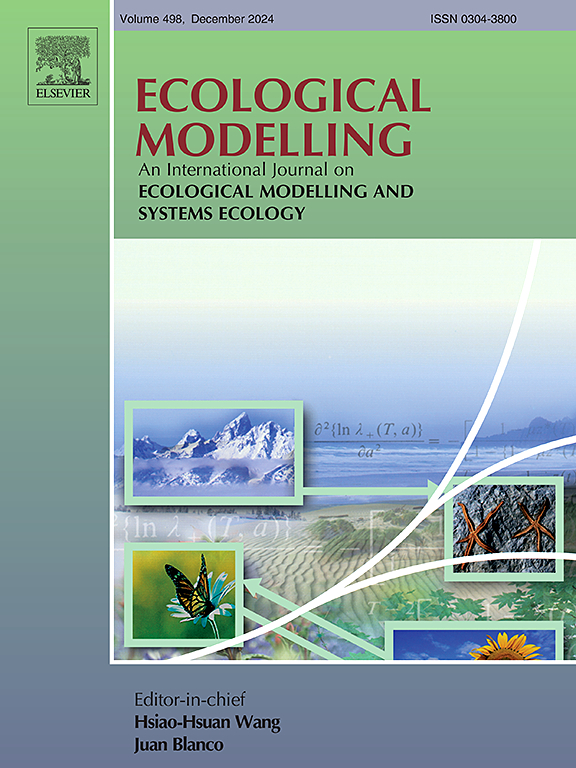用于理解生态系统行为的动力系统的机器学习模拟器
IF 2.6
3区 环境科学与生态学
Q2 ECOLOGY
引用次数: 0
摘要
最小模型(MM)旨在捕捉复杂系统的简化行为,以促进系统级分析,这在更复杂的数值模型中是不可行的。然而,最小模型开发中涉及的选择严重依赖于专家知识,这是可能干扰良好建模实践的偏见来源。本文提出了一种新的方法,其中机器学习(ML)模型使用由详细的基于物理的数值模型生成的瞬态数据进行训练,预测目标状态变量在给定其当前值和附加驱动因素的情况下的变化率。然后使用训练好的模型来模拟用传统最小模型进行的分析。这种方法(ML-MM)被部署在一个半干旱的山坡生态系统中,表征其土壤和植被成分。ML-MM输出与以前基于专家的结果具有大部分的一般特征,但显示出边坡更好的能力:(1)恢复植被,(2)抵抗土壤完全消失,(3)在稳定状态下达到更高的土壤深度。此外,在已知的健康平衡和退化平衡之间发现了一个新的中间稳定平衡,揭示了一个更复杂的生态系统崩溃模式,避免了关键转变,这得到了数值模型模拟的支持。还研究了瞬态行为,从中我们得出结论,系统可以表现出强烈的反应性,即在扰动后偏离平衡的初始偏差。总之,本研究证明了ML-MM在复杂系统上获得新的科学见解的潜力,这可能是基于专家的替代方法所错过的。因此,最小模型可以从在其开发过程中合并详细的数值模型和数据驱动的简化中获益良多。最终,这种方法可以应用于许多研究领域,甚至可以扩展到观测数据,增强我们对现实世界复杂系统动力学的理解。本文章由计算机程序翻译,如有差异,请以英文原文为准。

Machine learning emulators of dynamical systems for understanding ecosystem behaviour
Minimal models (MM) aim to capture the simplified behaviour of complex systems to facilitate system-level analyses that would be unfeasible with more sophisticated numerical models. However, the choices involved in minimal model development heavily rely on expert knowledge, a source of bias that can interfere with good modelling practices. In this paper, a new method is proposed in which a machine learning (ML) model is trained with transient data generated by a detailed physically-based numerical model, predicting the rate of change of the target state variables given their current value and additional drivers. The trained model is then used to mimic the analysis made with traditional minimal models. This approach (ML-MM) is deployed in a semiarid hillslope ecosystem characterising its soil and vegetation components. The ML-MM outputs share most of the general features with previous expert-based results but show a better ability of the hillslope to (1) recover its vegetation, (2) resist total disappearance of the soil and (3) reach substantially higher soil depths in steady state. Furthermore, a new intermediate stable equilibrium is found between the already known healthy and degraded ones, revealing a more complex pattern of ecosystem collapse that avoids a critical shift, as supported by numerical model simulations. The transient behaviour is also investigated, from which we conclude that the system can exhibit strong reactivity, that is, an initial deviation away from equilibrium after a perturbation. In conclusion, the present study demonstrates the potential of ML-MM to obtain new scientific insights on complex systems that might be missed by expert-based alternatives. Hence, minimal models may benefit greatly from incorporating detailed numerical models and data-driven simplification in their development process. Ultimately, this methodology could be applicable to many fields of study and even be expanded to observational data, enhancing our understanding of real-world complex system dynamics.
求助全文
通过发布文献求助,成功后即可免费获取论文全文。
去求助
来源期刊

Ecological Modelling
环境科学-生态学
CiteScore
5.60
自引率
6.50%
发文量
259
审稿时长
69 days
期刊介绍:
The journal is concerned with the use of mathematical models and systems analysis for the description of ecological processes and for the sustainable management of resources. Human activity and well-being are dependent on and integrated with the functioning of ecosystems and the services they provide. We aim to understand these basic ecosystem functions using mathematical and conceptual modelling, systems analysis, thermodynamics, computer simulations, and ecological theory. This leads to a preference for process-based models embedded in theory with explicit causative agents as opposed to strictly statistical or correlative descriptions. These modelling methods can be applied to a wide spectrum of issues ranging from basic ecology to human ecology to socio-ecological systems. The journal welcomes research articles, short communications, review articles, letters to the editor, book reviews, and other communications. The journal also supports the activities of the [International Society of Ecological Modelling (ISEM)](http://www.isemna.org/).
 求助内容:
求助内容: 应助结果提醒方式:
应助结果提醒方式:


